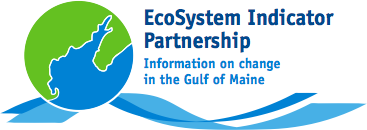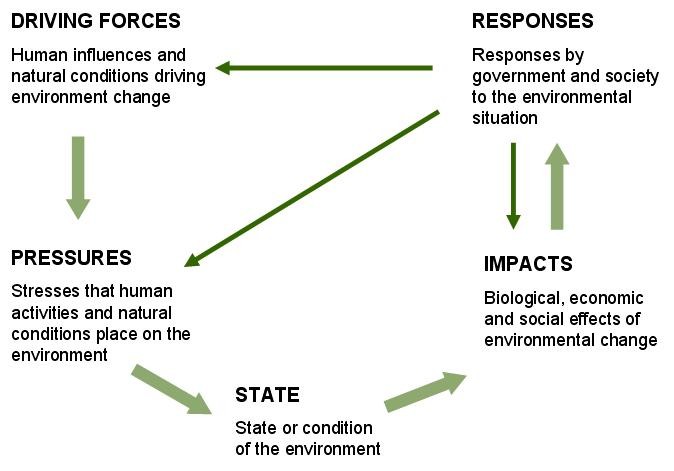Driving Forces-Pressures-State-Impacts-Response Framework
The reporting framework used in the State of the Gulf of Maine Report is the driving forces-pressures-state-impacts-response (DPSIR) framework. The DPSIR framework provides an overview of the relation between the environment and humans. According to this framework, social and economic developments and natural conditions (driving forces) exert pressure on the environment and, as a consequence, the state of the environment changes. This leads to impacts on human health, ecosystems and materials, which may elicit a societal or government response that feeds back on all the other elements.The DPSIR framework is useful in describing the origins and consequences of environmental problems.
Indicators
An indicator summary is provided at the end of each theme paper. The summary identifies indicators relevant to the theme paper and the policy issue it represents. The type of indicator is identified (driving force, pressure, state, impact or response) and an assessment of the indicator provided. The general trend of the indicator is shown as either a positive trend, a negative trend, an unclear or neutral trend, or no assessment due to lack of data. An overall assessment of the current situation is provided as "good", "fair" or "poor". An indicator is a parameter that provides information about an environmental issue with a significance that extends beyond the parameter itself. Indicators have been used for many years by economists to explain economic trends, a typical example being gross domesticproduct (GDP). More recently there have been efforts aimed at developing indicators that are suitable for measuring sustainable development. The main goal of establishing indicators is to measure, monitor and report on progress towards sustainability. A set of indicators should be broad enough to represent the overall environment, yet be few enough to present an understandable picture of environmental quality. Developing good indicators is in a continuous process of improvement. There are several indicator development and reporting initiatives within the Gulf of Maine, the only gulf-wide one being the Ecosystem Indicator Partnership (ESIP) of the Gulf of Maine Council. Since 2006, ESIP has been active developing a set of core indicators for the six priority areas for the Gulf of Maine. Wherever possible, if data had been collected and analysed by ESIP, these indicators were used in the State of the Gulf of Maine Report. Scoping Document
For more information on the development of the State of the Gulf of Maine Report see: Gulf of Maine State of the Environment Reporting: Scoping Document [ Back to Top of Page ] |

 
|
|||||||||||||||||


 Click for RSS feed
Click for RSS feed